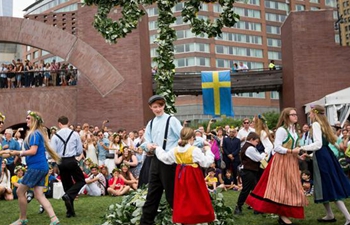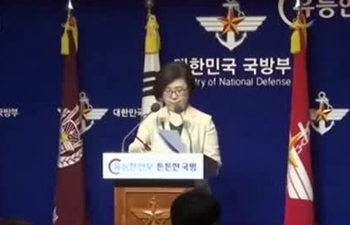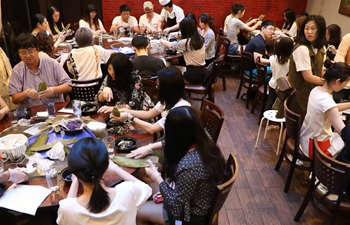SAN FRANCISCO, June 23 (Xinhua) -- A Stanford University professor's art project based on the ancient city of Dunhuang in northwest China is expected to promote the understanding of the Asian country in the contemporary age.
Xie Xiaoze, the Paul L. & Phyllis Wattis Professor of Art at Stanford University, presented his work-in-progress to the public Thursday night at Stanford University in Palo Alto, California.
The project, called "the amber of history," is inspired by the artist's 25 days of artist residency in the summer of 2017 at the Mogao Grottoes in Dunhuang, a historic site of Buddhist art on the ancient Silk Road.
Mogao Grottoes are hundreds of cave temples carved more than 1,000 years ago in Dunhuang. The caves, decorated with Buddhist murals and sculptures, are a World Heritage site.
Xie's research focused on Cave 17, known as the Library Cave. Once an important cache of manuscripts, scrolls, paintings and textiles sealed up by walls from the fourth to the 11th century, the cave is now empty and relics are dispersed in collections around the world.
He showed the audience a photo he took at the site, in which a big rock bears the inscription of "Dunhuang is the history of sorrow for our academia" by Chinese historian Chen Yinke, who regretted the loss of the valuable cultural relics that had adversely affected the study of Dunhuang inside China.
Xie said he took long walks into deserts for inspiration and spent a week making research at Dunhuang Academy before moving to the studio.
Through a long scroll of brush and ink drawings, combined with diagrams, calligraphy and quoted images, Xie casts his imaginations of the now empty cave and confronts its history of loss, absence and trauma.
The drawings are a framework for an ambitious project, which will include a number of sculptures representing the "original order" of the cave through his "versions of imagination."
He explained a few versions at the presentation, including "texture of realization," "re-imagination of colors" and "symphony of languages."
Xie said he would continue to create more versions and test materials while seeking funding for his project. He will return to Dunhuang later this year for further studies.
The presentation was co-sponsored by Tsinghua Institute of Culture and Creativity, and the Dunhuang Foundation, a San Francisco-based organization which sponsored Xie's artist residency program in Dunhuang last year.
The program aims to help American people better understand China through traditional culture.
Deputy Chinese Consul General in San Francisco Zha Liyou, who also attended the presentation, encouraged artists in both China and the United States to contribute to the people-to-people exchanges between the two countries through cultural projects.













